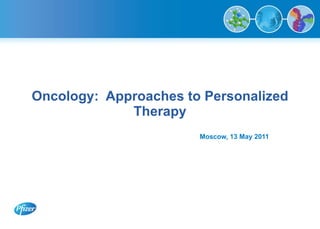–ö.–Δ–≤–Β―Ä―¹–Κ–Ψ–Ι, Pfizer
- 1. Oncology: Approaches to Personalized Therapy Moscow, 13 May 2011
- 2. What is βÄ€PrecisionβÄù or βÄ€PersonalizedβÄù Medicine? Medicines targeting patient segments that will have an optimal response to therapy Building disease understanding to identify the right pathways and targets Linking disease understanding and clinical outcomes Precision Medicine Segmented, not personalized (5-20%+ patient subgroups, not individuals)
- 3. Right Target Genetic validation; Rare phenotypes What are we trying to accomplish? Right Drug (or Combinations) Selective design and delivery; Combinations for complex diseases Right Patient Phenotyping and Genotyping
- 4. Deletion of p16 and amplification of Cyclin D with wild type retinoblastoma (Rb) predict for sensitivity to CDK4/6 inhibitor Novel CDK4/6 inhibitor PD 0332991 : Proof of Concepts to be performed in Luminal B breast cancer and Multiform Glioblastoma (GBM) 12% ALL BREAST CANCER 6.3% 36.5% 12% 14.4% Precision Medicine today : Oncology is pursuing a novel approach in breast cancer targeting Cyclin D Kinase 4/6 (CDK4/6) CDK4/6 Program Highlights Opportunity for Patient Segmentation in Breast Cancer Finn et al; Breast Cancer Research 11(5); 2009 HER2 + Luminal B Basal Luminal A
- 5. Right Target Genetic validation; Rare phenotypes What are we trying to accomplish? Right Drug and Combinations Selective design and delivery; Combinations for complex diseases Right Patient Phenotyping and Genotyping
- 6. LINKER Calicheamicin Inotuzumab: Specific mAb-like target binding allows targeted delivery to cancer cells Inotuzumab ozogamicin is an anti-CD22 antibody-calicheamicin conjugate focused delivery of cytotoxic agent to tumor cells may maximize its antitumor effect Major B-cell malignancy currently under study: Non-HodgkinβÄôs Lymphoma (NHL) Phase 2 study with Inotuzumab plus Rituximab in refractory NHL demonstrated positive proof of concept, with strong efficacy and favorable tolerability Additional opportunity in other NHL types and B-cell leukemias CMC-544 Internalized Linker Hydrolized Calicheamicin Released Intracellularly DS DNA Breaks Apoptosis
- 7. Median Overall Survival not reached Progression Free Survival Median 7.8 months Inotuzumab βÄ™ Phase II clinical activity in Aggressive Non-HodgkinβÄôs Lymphoma (NHL) Outcomes in relapsed, refractory Diffuse Large B-cell Lymphoma or transformed follicular NHL exceeding current Standard of Care Median survival not reached in patients who have failed prior chemotherapy Proof of Concept Achieved September 2010 Emerging clinical data in combination with rituximab suggests probability of technical success in Phase III is greater than 95%
- 8. Right Target Genetic validation; Rare phenotypes What are we trying to accomplish? Right Drug (or Combinations) Selective design and delivery; Combinations for complex diseases Right Patient Phenotyping and Genotyping
- 9. Molecular Subtypes in Lung Cancer An Evolving Landscape of Medical Need Seg. 1 K-ras mut No targeted therapy Chemotherapy ineffective Seg. 4 LKB1 PI3K/mTor Seg. 2 EML4/Alk crizotinib Seg. 3 EGFR erlotinib Seg. 5 MYC No therapy c-Met amplification/ErbB amplification EGFR T790M GK mutation EGFR T790M GK mutation/c-Met amplification Resistance mechanisms
- 10. Targeting Lung Cancer Treatments in Patient Subsets to Improve Outcomes 1. Shaw AT et al., J Clin Oncol. 2009; 27:4247-4253 2. Manabu Soda et al., Nature 2007; 448, 561-566 Highly effective therapy Overall response rate = 65% Disease control rate = 84% at a median of ~24 weeks Accelerated clinical activities Initiated Phase 3 trial based on Phase 1 results, bypassing Phase 2 and accelerating development timeline Crizotinib: A potent and selective oral inhibitor of MET and ALK ... initially being developed for MET mechanism New Phase I trial targeting advanced NSCLC patients harboring ALK rearrangement Academic discovery of new patient segment redefined lung cancer 10-15% 1 of non small cell lung cancer (NSCLC) patients with fusion oncogene ELM4-ALK 2 are unresponsive to conventional EGFR inhibitor 1 treatment
- 11. Note: Patients in trial composed of 2 nd to 4 th line. 1 st line response to Standard of Care: ~50%, 2 nd line: ~10%, 3 rd line: 3-5% Clinical Outcome for NSCLC Patients After Crizotinib Treatment
- 12. Pre-Treatment (FLT-PET) After 4 weeks of Crizotinib 43-yr old Male Non-smoker with NSCLC ALK Fusion
- 13. Thank you for your attention!












